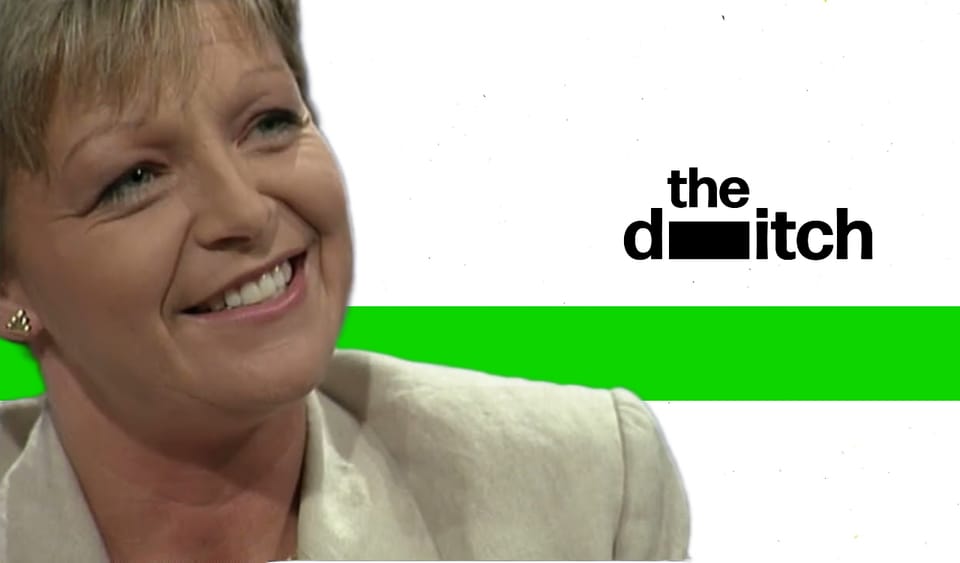On this day 29 years ago investigative journalist Veronica Guerin was driving on the Naas Road. As she waited at a red light a motorbike carrying two male passengers appeared next to her. They’d been tracking her after a court date about a speeding offence earlier that day. One of the men, sitting on a pillion, smashed her passenger window. He fired six shots, killing Guerin. She was 37 years old.
Guerin had built a considerable public profile as a journalist for the Sunday Independent, writing stories about criminals, often taking significant risks with her personal safety to get information. She doorstepped violent underworld figures like John Gilligan, who once assaulted her when she showed up at his home in Enfield, county Meath. Her murder caused moral outrage. Newspapers dedicated countless articles to discussing it. The Sunday Independent ran a televised advertisement featuring a black and white photo of Guerin and the caption: “News is something that someone, somewhere, doesn’t want published.” Then taoiseach John Bruton called the shooting an “attack on democracy.” Government – Fine Gael, Labour and Democratic Left – resolved to fight organised crime, quickly establishing the Criminal Assets Bureau, which seized assets from Gilligan and others.
Guerin was understandably portrayed as a singularly brave journalist, prepared to do whatever she thought justified to expose wrongdoing. She faced death threats from people capable of following through on them. In January 1995 a masked man knocked on the door of her house and shot her in the leg when she opened it. (The Irish Times reported that gardaí initially believed this attack was a warning to stop writing articles about Gerry “The Monk” Hutch but later concluded it was an attempt on her life by associates of drug dealer Martin Cahill.)
She also wrote excellent reports. For example Guerin broke a story about how the office of the attorney general didn’t act for seven months after a request from the north to extradite paedophile Catholic priest Brendan Smyth to face nine charges about the sexual abuse of four boys. It ultimately caused the Fianna Fáil-Labour government to collapse.
After Guerin's death several of her colleagues and associates privately said she might still be alive if her employer had taken greater responsibility with her security. Veronica Guerin: The Life and Death of a Crime Reporter by former journalist Emily O’Reilly, who now serves as the European Ombudsman, captured some of these opinions. O'Reilly presents us with a gifted but reckless journalist whose inclinations found their perfect, and ultimately fatal, match in a newspaper that didn't particularly care to restrain her.
'I think we live or die by the market'
Among the criticisms levelled by O'Reilly – who interviewed the likes of Dublin inner city TD Tony Gregory, former Business Post editor Damien Kiberd, editor of The Phoenix Paddy Prendiville, columnists John Waters and Fintan O'Toole – was the Sunday Independent’s approach, which focused on personalities and put journalists at the centre of their stories, made Guerin a target for the people on whom she was reporting. Though some interviewees suggested Guerin's determination made her difficult to rein in, the book condemned a culture in the Sunday Independent that rewarded the risky methods Guerin used to produce stories.
Among the most vociferous critics of the Sunday Independent is Prendiville who in 2016 published a piece denouncing the paper and outright blaming it for the death of his friend. Prendiville took aim at what he saw as institutional hypocrisy: while editorial executive Willie Kealy publicly attacked critics of the paper's handling of Guerin, several prominent Independent News and Media figures told Prendiville The Phoenix's criticisms of its editorial policies were justified.
The Sunday Independent, Prendiville argued, refused to admit that executives had ignored clear threats to Guerin's safety. Instead of accepting its failures to protect its employee, the paper created what he called a "misleading and self-promoting chronicle" that perpetuated the same editorial culture – one inflating both journalist and newspaper – that compounded the danger Guerin faced.
The culture in which Guerin worked her assignments is perhaps best captured in remarks made by Sunday Independent editor Aengus Fanning two years before her death. "Most newspapers might see journalism as a higher calling and the market may be incidental," he told interviewer Ivor Kenny in 1994. "I think we live or die by the market." O'Reilly places this quote at the opening of her book, which was originally titled Dying for the Story. Guerin’s interactions with criminals were not just byproducts of investigative journalism but commercial assets in a market that demanded spectacle.
Entering that world
In September 2017 I published a piece in VICE UK that criticised Irish crime journalism. I said tabloid crime reporting is like journalism about celebrities, featuring fashion coverage at gangsters' funerals and lifestyle features about their girlfriends' spending habits. I stand over points I made about the tone of some of these stories, as well as an overreliance on official sources. But almost eight years later I think some of my arguments were reductive, resembling the same Good vs Bad narratives I condemned in the piece as editorially irresponsible. I overstated the role of individual journalistic failures and understated the structural and legal reasons – defamation laws, economic pressures – that shape how crime is reported in Ireland. And I didn’t fully acknowledge that this reporting can be in the public interest, exposing criminal networks.
Besides, a more interesting subject is why crime is such a popular genre in the first place. Stories about organised crime offer something that most other reporting typically cannot: life-and-death stakes played out in real time, access to a forbidden world that most readers will never enter.
And when you report on crime, even from what feels like a distant place, you become a presence in that world whether you intend to or not. I discovered this for myself in February and March 2020, when I got multiple emails from encrypted accounts trying to commission work – one using the handle “projectdjk” (Daniel Kinahan's initials, in a format that resembled a Twitter handle he previously used). Another claimed to be from an “S.P. O'Neill” representing a sports website and based “in the Middle East”. O'Neill praised my article on crime reportage and said I had taken a stance against what they called "specialist interests" influencing Irish media. "I was very impressed with the Vice article," he wrote, adding he had been following my posts on Twitter.
This correspondence coincided with Daniel Kinahan's efforts to repair his public image – a campaign that included backing a film about the Regency Hotel attack and arranging an interview with social media influencer James English that was never published. According to Nicola Tallant's book Clash of the Clans, Kinahan and his people were using encrypted accounts during this period. I'm not comparing myself to Veronica Guerin – the point here is that by reporting on any issue you create a kind of relationship with your subjects, whether you want to or not. Something to always remember when working as a journalist: if you write about someone, there’s a good chance they’ll read it.
There is usually no need to make oneself a participant in stories about crime, particularly in a city as small as Dublin. What's troubling about Veronica Guerin's death isn't that she took risks with her safety – many reporters do that – but that she worked in an industry that made her the star of personality-driven stories, likely placing her in greater danger than necessary, while rewarding the increasingly confrontational methods it should never have allowed her to pursue.


